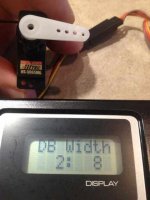You are using an out of date browser. It may not display this or other websites correctly.
You should upgrade or use an alternative browser.
You should upgrade or use an alternative browser.
Who plays with resetting deadband?
- Thread starter kevinjulieevan
- Start date
wedoitall
Member
i want to learn all about this. i think this should be an article. i would do it , LOL but i dont know squat.
also would like to know if theres anyway of testing your servos, stuff i could check out first to see if i need to send off to Hitec. or can i only check out the gears.
which programmer did you get Kevin?
i would like to know the difference in the programmer. also would like to know if theres any tools to check out analog servos also.
also would like to know if theres anyway of testing your servos, stuff i could check out first to see if i need to send off to Hitec. or can i only check out the gears.
which programmer did you get Kevin?
i would like to know the difference in the programmer. also would like to know if theres any tools to check out analog servos also.
Ohio AV8TOR
Just Do It
Great thread that I will be following.
gyro
GSN Contributor
I have in the past set all my servos to zero, so they are at a minimum, equal.
I'd be interested to learn if there are any specific advantages to setting them higher.
My understanding is the higher the number, the less the servo works to be at the commanded input... Both center and/or a given commanded deflection.
I'd be interested to learn if there are any specific advantages to setting them higher.
My understanding is the higher the number, the less the servo works to be at the commanded input... Both center and/or a given commanded deflection.
kevinjulieevan
50cc
from what i can tell so far the lower the number the better the centering. so zero sounds great but i'm just afraid the servos might get jittery or buzz a bunch if they are constantly searching for that perfect point. seems the servos would pull a higher load on the bec/esc. docaustin on rcgroups mentions resetting deadbands a fair bit. wonder if he would write an article for us?
gyro
GSN Contributor
from what i can tell so far the lower the number the better the centering. so zero sounds great but i'm just afraid the servos might get jittery or buzz a bunch if they are constantly searching for that perfect point. seems the servos would pull a higher load on the bec/esc. docaustin on rcgroups mentions resetting deadbands a fair bit. wonder if he would write an article for us?
He'd write it for his blog!
he just discovered it himself recently, but I think it'd be a great article regardless.
Let me see if I can get any explanation on it from my contacts at Hitec/
Last edited by a moderator:
Ohio AV8TOR
Just Do It
Try to get us a deal on the HFP-25 while you hit em up.Let me see if I can get any explanation on it from my contacts at Hitec/
MattInFla
50cc
Servo dead band refers to the electrical width of the center point of travel.
For instance, a typical center point is 1500 microseconds.
With a deadband of 0, the servo would interpret a pulse of 1501 microseconds to be off center.
With a deadband of 1, the servo would consider 1499, 1500, and 1501 to be center.
With a deadband of 2, the servo considers 1498 - 1502 microseconds as center.
But why do we care? Well, if we have a single servo per control surface, we really don't (unless the deadband value is way out of whack). But if we have two or more servos ganged on a surface, it becomes important. Each servo may have a minutely different time reference. So one servo might see a pulse and call it 1500 microseconds, while a second servo sees the same pulse as 1498 microseconds.
If both of these servos have a deadband of 0 or 1, they will push against one another to get to their own preferred center. This, of course, is hard on the servos and drains the radio battery (or loads the BEC). So setting the deadband in both servos to 2 or 3 microseconds eliminates the conflict and cancels the electromechanical wrestling match.
Here is Hitec's much shorter version: http://www.hitecrcd.com/support/faq...nd-width-and-why-do-i-want-to-program-it.html
For instance, a typical center point is 1500 microseconds.
With a deadband of 0, the servo would interpret a pulse of 1501 microseconds to be off center.
With a deadband of 1, the servo would consider 1499, 1500, and 1501 to be center.
With a deadband of 2, the servo considers 1498 - 1502 microseconds as center.
But why do we care? Well, if we have a single servo per control surface, we really don't (unless the deadband value is way out of whack). But if we have two or more servos ganged on a surface, it becomes important. Each servo may have a minutely different time reference. So one servo might see a pulse and call it 1500 microseconds, while a second servo sees the same pulse as 1498 microseconds.
If both of these servos have a deadband of 0 or 1, they will push against one another to get to their own preferred center. This, of course, is hard on the servos and drains the radio battery (or loads the BEC). So setting the deadband in both servos to 2 or 3 microseconds eliminates the conflict and cancels the electromechanical wrestling match.
Here is Hitec's much shorter version: http://www.hitecrcd.com/support/faq...nd-width-and-why-do-i-want-to-program-it.html
Last edited by a moderator:

